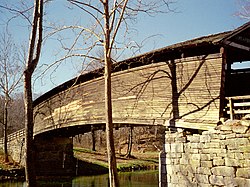Humpback Covered Bridge
|
Humpback Covered Bridge
|
|

The Humpback Covered Bridge is one of the last remaining bridges of its type in the U.S.
|
|
| Location | Alleghany County, Virginia |
|---|---|
| Nearest city | Covington, Virginia |
| Coordinates | 37°48′2.15″N 80°2′49.24″W / 37.8005972°N 80.0470111°WCoordinates: 37°48′2.15″N 80°2′49.24″W / 37.8005972°N 80.0470111°W |
| Built | 1857 |
| NRHP Reference # | 69000219 |
| VLR # | 003-0002 |
| Significant dates | |
| Added to NRHP | October 1, 1969 |
| Designated NHL | October 16, 2012 |
| Designated VLR | November 5, 1968 |
The Humpback Covered Bridge located in the U.S. state of Virginia, is one of the few remaining covered bridges in the United States that was built higher in the middle than on either end; hence the name of "humpback". The bridge was built in 1857 and is also the oldest remaining covered bridge in the state of Virginia. Its WGCB number is 46-03-01. The bridge spans a tributary of the Jackson River known as Dunlap Creek, for a distance of 109 feet (33 m). The humpback feature is 4 feet (1.2 m) higher in the center than at either end. The bridge is located near the city of Covington, Virginia.
Covered bridges were first built in the 1810s when it was determined that adding a roof over wooden bridges would better protect the decking and support trusses and increase the lifespan of the bridge. The decking and support systems of the era would last an average of ten years on uncovered wooden bridges. As was later discovered, covered wooden bridges ultimately averaged ten times the lifespan of uncovered ones. Covered bridges were sometimes referred to as "kissing bridges" during the more modest era of the late 19th Century, as the privacy from passing through a covered bridge would allow passengers in horse and buggy an opportunity to kiss each other unobserved.
Three bridges stood at approximately the same location as Humpback Covered Bridge does today. The first bridge was built in the 1820s and was destroyed by a flood in 1837. A second bridge built the next year was also damaged beyond repair by a flood on July 13, 1842. The third bridge collapsed in 1856 due to heavy use and fatigue from weathering. None of these earlier bridges were either arched or covered. All three bridges were a part of the James River and Kanawha Turnpike, a heavily used mountain road that connected the Shenandoah Valley with the Alleghany Mountains and areas further west. The current bridge was built in 1857 and the design of both covering and also arching the bridge was hoped to increase the longevity of the bridge by protecting the midsection from future floods and the decking from the ravaging effects of moisture and sunlight. The decking, unlike houses and other structures, could not be painted to prevent deterioration, as the traffic from horses and wagons would quickly remove any available paints of the era.
...
Wikipedia
